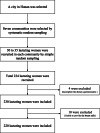Dietary patterns and their association with breast milk macronutrient composition among lactating women
- PMID: 32503555
- PMCID: PMC7273657
- DOI: 10.1186/s13006-020-00293-w
Dietary patterns and their association with breast milk macronutrient composition among lactating women
Abstract
Backgroud: Breast milk is the optimal food for infant growth and development. The purpose of this study was to evaluate the association between breast milk macronutrient composition with dietary pattern among lactating women.
Methods: A total of 220 lactating women from 2011 to 2012 in Changsha, a city of south-central China, was recruited using a multi-stage sampling method. Breast milk was collected, and the protein, fat, lactose, total dry matter, and energy contents of breast milk were measured. A 24 h recall method on three consecutive days was used to collect the dietary information of lactating women and an exploratory factor analysis was performed was to identify dietary patterns. The association between the concentration of a breast milk component and dietary pattern was assessed using a multivariable linear regression model.
Results: Three major dietary patterns were classified. Lactating women with dietary pattern 1 mainly ate fresh vegetables and fresh legumes. Those with dietary pattern 2 mainly ate red meat, cereals and eggs, and those with dietary pattern 3 mainly ate fungi and algae, dries legumes and soy milk. Pattern 2 was positively associated with the concentration of protein (B = 0.07, 95% CI 0.00, 0.15), total dry matter (B = 0.20, 95% CI 0.02, 0.38) and energy (B = 1.66, 95% CI 0.03, 3.30) in breast milk. Morever, lactation period was negatively associated with the protein and total dry matter concentrations and positively associated with lactose.
Conclusions: The results show the lactation period was an important factor affecting milk composition and a dietary pattern with high intake of red meat, cereals, and eggs was associated with higher protein, total dry matter, and energy contents in breast milk. These findings show that the dietary patterns of lactating women can affect breast milk macronutrient composition and provide a foundation for improving child health.
Keywords: Breast milk; Dietary patterns; Lactating women; Macronutrient; Principal component analysis.
Conflict of interest statement
The authors declare that they have no competing interests.
Figures


References
-
- World Health Organization . Global Strategy for Infant and Young Child Feeding. 2003.
-
- Yang T, Zhang L, Bao W, Rong S. Nutritional composition of breast milk in Chinese women: a systematic review. Asia Pac J Clin Nutr. 2018;27(3):491–502. - PubMed
MeSH terms
LinkOut - more resources
Full Text Sources
Research Materials

